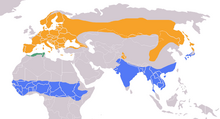| Wrynecks | |
|---|---|

| |
| Eurasian wryneck (Jynx torquilla) Punjab, India | |
| Scientific classification | |
| Domain: | Eukaryota |
| Kingdom: | Animalia |
| Phylum: | Chordata |
| Class: | Aves |
| Order: | Piciformes |
| Family: | Picidae |
| Subfamily: | Jynginae |
| Genus: | Jynx Linnaeus, 1758 |
| Type species | |
| Jynx torquilla (Eurasian wryneck) Linnaeus, 1758
| |
| Species | |

| |
| Range map for Eurasian wryneck | |

| |
| Range map for red-necked wryneck Summer Resident Winter | |
The wrynecks (genus Jynx) are a small but distinctive group of small Old World woodpeckers. Jynx is from the Ancient Greek iunx, the Eurasian wryneck.
These birds get their English name from their ability to turn their heads almost 180°. When disturbed at the nest, they use this snake-like head twisting and hissing as a threat display. It has occasionally been called "snake-bird" for that reason.[1]
Like the true woodpeckers, wrynecks have large heads, long tongues, which they use to extract their insect prey, and zygodactyl feet, with two toes pointing forward and two backwards, but they lack the stiff tail feathers that the true woodpeckers use when climbing trees, so they are more likely than their relatives to perch on a branch rather than an upright trunk. The sexes have a similar appearance.[2]
Their bills are shorter and less dagger-like than in the true woodpeckers, but their chief prey is ants and other insects, which they find in decaying wood or almost bare soil. They reuse woodpecker holes for nesting, rather than making their own holes. The eggs are white, as with many hole nesters.
The two species have cryptic plumage, with intricate patterning of greys and browns. The adult moults rapidly between July and September, although some moult continues in its winter quarters.[3]
- ^ Newton, Alfred (1911). . In Chisholm, Hugh (ed.). Encyclopædia Britannica. Vol. 28 (11th ed.). Cambridge University Press. p. 854.
- ^ "Woodpeckers, Wrynecks, and Piculets (Picidae) | Encyclopedia.com". www.encyclopedia.com. Retrieved 28 March 2023.
- ^ RSPB Handbook of British Birds (2014). UK. ISBN 978-1-4729-0647-2.